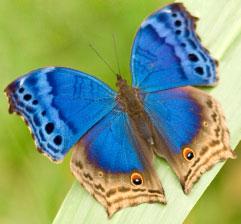Imagine you're a guy at a club in the dead of winter. Sexy ladies with stunning eyes are looking in your direction, each making a move. You look around. Perhaps they're smiling at a friend who's just arrived? No, they're looking at you! You can't believe your luck! Back in the summer, it was a completely different story. You had to do all the work. Could there be a Sadie Hawkins theme here? You decide to try your luck again the following night. Nope. Ladies all around are fighting for you! Amazing! But you can't help but wonder what is going on...usually it's the other way around...
When researchers at Yale University started looking at mating patterns in African butterflies what they observed was very much like our stupefied guy's situation. They found that the temperature to which butterflies were exposed as caterpillars dictated their courting behavior. When butterflies developed during the warm season, then it was up to the males to make the first move, and the females could play hard to get. In the cold season, however, it was the complete opposite. Females had to throw their inhibitions to the wind and make their move on the male of their liking.
Why does this happen? Typically speaking, the gender that chooses has more to lose by accepting the advances of a less than ideal partner. Another way to think about this is that the gender that chooses has more to invest. Think about the relative size (and number) of sperm and egg cells. In humans, an egg cell is HUGE compared to a sperm cell. Moreover, a female will produce one egg, maybe two, each month, while a male lets loose millions of sperm each time he has a happy ending. Therefore, it is to the female's benefit to choose wisely, lest she be up the reproductive creek without a helping paddle. As Matt Ridley so wisely put it in the Red Queen, "a female...gives birth to a gigantic baby that has been nurtured inside her for a long time; a male can become a father in seconds. Women cannot increase their fecundity by taking more [partners]; men can."
This is very similar to what happens in African butterflies, except that the amount of parental investment between the sexes changes from one season to the next. In the warm season, when the females choose, the females stand to lose more, while in the cold season, it is the reverse. A cold season male gives his lady friend a spermatophore, a capsule filled with nutrients, a trust fund so to speak, that helps her to live longer and to lay more eggs. In the warm season, however, there are plenty of nutrients to go around, and as Dr. Antónia Monteiro, who led the study at Yale, explains, "females don't need to gather [food] from males and males invest only in cheap sperm. Male's don't need to be choosy about picking a female because they don't suffer a cost to mating [repeatedly]. Females, however, will need to make the right mating decision because they will lay eggs right after mating [in the warm season] and if they mate with a sub-optimal male, they will have infertile or poor quality offspring."
So how does a choosing male or female butterfly know if her potential mate is worth the risk? Once again, it's all about the eyes. Well, the eyespots in this case. These butterflies have the rings on their wings. These are commonly known as eyespots, and the white center as the pupil. What Dr. Monteiro's group found was that regardless of who was doing the choosing, both males and females preferred to get down with someone with who had a nice, visible pupil. Conversely, those doing the courting had large pupils to alert potential mates that they were the cream of the crop. Because both males and females use eyespots as a means to attract the opposite sex, these ornaments have been preserved across genders, suggesting that sexual role reversal may affect a species' physical traits.
To find out more about this study, please visit the Science magazine website. You can also view this blog post at http://basicresearch1.blogspot.com/

